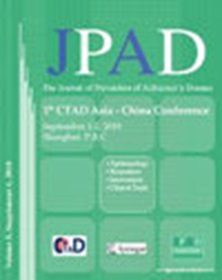Where Do We Go from Here?
IF 7.8
3区 医学
Q1 CLINICAL NEUROLOGY
引用次数: 0
Abstract
Budd Haeberlein and colleagues presented the data from the two randomized Phase 3 studies of aducanumab in early Alzheimer’s disease (AD) recently in JPAD (1). The data have been carefully evaluated by the field over the past few years and are now finally reported for closer scrutiny. Essentially, the two studies involved 3,285 participants with mild cognitive impairment or mild dementia due to underlying AD as documented by amyloid positivity. One study, EMERGE, demonstrated statistically significant findings on the primary outcome measure, three secondary measures and a tertiary measure. The parallel study, ENGAGE, failed to replicate these results. The sponsor did post hoc analyses on the ENGAGE study to rationalize its failure to replicate the EMERGE results and suggested several plausible hypotheses. Central to this discussion was the implementation of protocol amendments during the conduct of the study that may have differentially influenced the outcomes of the two studies. The studies were stopped for futility in March of 2019 according to predetermined guidelines. The sponsor, however, evaluated an expanded dataset beyond the data available to the iDMC and concluded that EMERGE demonstrated positive results while ENGAGE did not. The socio-political fallout of these studies has been enormous. From the original termination of the studies due to futility through the subsequent analyses of additional double-blinded data, the FDA’s willingness to entertain a filing, the FDA Advisory Committee’s recommendations, the accelerated approval by the FDA on June 7, 2021, and the subsequent consideration for coverage by CMS have resulted in a firestorm. As such, it may be time to step back from the media circus and look at the implications of these studies for the field and, most importantly, our patients. An interpretation of these data could conclude that there is a positive effect of aducanumab on clinical progression of AD, but the effect is modest. The combination of the positive results from the EMERGE study would be statistically quite unlikely to have happened by chance. However, these data need to be interpreted in the context of the negative results from the parallel study, ENGAGE. This may reflect reality. The impact of intervention on amyloid at the stage of plaque development, along with the symptoms of mild cognitive impairment or mild dementia, may be minimal. If one accepts the putative explanation of the development of AD pathophysiology with amyloid accumulation occurring over years to decades subsequently leading to tau hyperphosphorylation, synaptic dysfunction and cognitive impairment, then results of these types of amyloid interventions may be comprehensible. That is, if amyloid has built up over decades and if one is able to successfully reduce the plaque burden over the course of 12 to 18 months, what might be a reasonable clinical manifestation of that intervention? One could argue that the expectations should be quite modest but perhaps clinically real. The other monoclonal antibodies against amyloid that lower amyloid plaque levels currently under investigation are reporting congruent results of similar magnitude supporting the aducanumab data (2-4). As such, amyloid reduction at the plaque-formation stage might only be expected to have a minimal clinical impact. The EMERGE and ENGAGE studies suggest a positive effect on downstream biomarkers of the AD pathophysiologic cascade evidenced by tau PET, cerebrospinal fluid markers and plasma p-Tau181 measures. However, as the authors admit, these data are only suggestive due to the small number of participants involved in these substudies. Although the p-tau181 numbers were reasonable, this biomarker is least well validated in clinical trials. The only reliable biomarker data that resulted from this study involved the doseand time-dependent amyloid-lowering plaque measure obtained on amyloid PET. The other markers are certainly suggestive but hardly definitive regarding substantiation of the ultimate beneficial effect of aducanumab on lowering amyloid levels. The side effect profile of aducanumab is real and probably reflective of this class of therapies. The incidence of ARIA is significant but perhaps manageable with appropriate monitoring of the development of the ARIA-E and ARIA-H side effects (5). Subsequent data have suggested that these side effects, while real and potentially serious, can be managed and, in the appropriate setting, will allow the continuation of the therapy in most patients (6). I must take issue with the authors’ suggestion that the futility analysis was suspect. The iDMC made the correct decision given the data with which they were presented © Serdi and Springer Nature Switzerland AG 2022我们该何去何从?
Budd Haeberlein及其同事最近在JPAD(1)上发表了两项aducanumab治疗早期阿尔茨海默病(AD)的随机3期研究的数据。在过去几年中,该领域对这些数据进行了仔细评估,现在终于报告了这些数据,以进行更仔细的审查。从本质上讲,这两项研究涉及3285名参与者,他们患有淀粉样蛋白阳性记录的潜在AD引起的轻度认知障碍或轻度痴呆。一项名为EMERGE的研究在主要结果指标、三个次要指标和一个第三指标上显示了统计上显著的发现。平行研究ENGAGE未能重复这些结果。发起人对ENGAGE研究进行了事后分析,以解释其未能复制EMERGE结果的合理性,并提出了几个似是而非的假设。本次讨论的核心是在进行研究期间执行议定书修正案,这可能对两项研究的结果产生不同的影响。根据预先确定的指导方针,这些研究于2019年3月因无效而停止。然而,发起人评估了iDMC可用数据之外的扩展数据集,并得出结论,EMERGE显示出积极的结果,而ENGAGE则没有。这些研究的社会政治影响是巨大的。从最初由于对额外双盲数据的分析无效而终止研究,到FDA愿意接受申请,FDA咨询委员会的建议,FDA于2021年6月7日加速批准,以及随后考虑CMS的覆盖范围,这些都导致了一场风暴。因此,也许是时候从媒体的喧嚣中退一步,看看这些研究对该领域的影响,最重要的是,对我们的患者的影响。对这些数据的解释可以得出结论,aducanumab对阿尔茨海默病的临床进展有积极作用,但作用是温和的。从统计数据来看,EMERGE研究的积极结果不太可能是偶然发生的。然而,这些数据需要在平行研究ENGAGE的负面结果的背景下进行解释。这可能反映了现实。干预在斑块形成阶段对淀粉样蛋白的影响,以及轻度认知障碍或轻度痴呆的症状,可能是最小的。如果人们接受对AD病理生理发展的假定解释,即淀粉样蛋白积累发生数年至数十年,随后导致tau过度磷酸化、突触功能障碍和认知障碍,那么这些类型的淀粉样蛋白干预的结果可能是可以理解的。也就是说,如果淀粉样蛋白已经积累了几十年,如果一个人能够在12到18个月的时间里成功地减少斑块的负担,那么这种干预的合理临床表现是什么?有人可能会说,期望应该相当适度,但也许在临床上是真实的。目前正在研究的其他降低淀粉样蛋白斑块水平的抗淀粉样蛋白单克隆抗体也报告了相似的结果,支持aducanumab的数据(2-4)。因此,在斑块形成阶段减少淀粉样蛋白可能只会产生最小的临床影响。EMERGE和ENGAGE研究表明,通过tau PET、脑脊液标志物和血浆p-Tau181测量,对AD病理生理级联的下游生物标志物有积极作用。然而,正如作者所承认的那样,由于这些子研究的参与者人数较少,这些数据仅具有启发性。尽管p-tau181的数量是合理的,但这种生物标志物在临床试验中得到的验证最少。该研究得出的唯一可靠的生物标志物数据涉及淀粉样蛋白PET获得的剂量和时间依赖性淀粉样蛋白降低斑块测量。其他标记物对于aducanumab在降低淀粉样蛋白水平上的最终有益效果的证实当然具有提示性,但很难确定。aducanumab的副作用是真实的,可能反映了这类治疗。ARIA的发生率是显著的,但通过对ARIA- e和ARIA- h副作用的发展进行适当的监测可能是可控的(5)。随后的数据表明,这些副作用虽然真实且潜在严重,但可以得到控制,并且在适当的环境下,将允许大多数患者继续治疗(6)。我必须对作者的建议提出质疑,即无效分析是可疑的。iDMC根据提供的数据做出了正确的决定©Serdi and施普林格Nature Switzerland AG 2022
本文章由计算机程序翻译,如有差异,请以英文原文为准。
求助全文
约1分钟内获得全文
求助全文
来源期刊

Jpad-Journal of Prevention of Alzheimers Disease
CLINICAL NEUROLOGY-
自引率
7.80%
发文量
85
期刊介绍:
The JPAD « Journal of Prevention of Alzheimer’Disease » will publish reviews, original research articles and short reports to improve our knowledge in the field of Alzheimer prevention including : neurosciences, biomarkers, imaging, epidemiology, public health, physical cognitive exercise, nutrition, risk and protective factors, drug development, trials design, and heath economic outcomes.
JPAD will publish also the meeting abstracts from Clinical Trial on Alzheimer Disease (CTAD) and will be distributed both in paper and online version worldwide.
 求助内容:
求助内容: 应助结果提醒方式:
应助结果提醒方式:


